Famous Buildings in Chicago – 15 Skyline Marvels
Chicago includes many famous buildings, and we are going to examine fifteen of them today. We are going to discuss some of their history, general design, and uses over the course of this article, which should serve as an informative look at some of these iconic structures. We will also look at why they have withstood the test of time as some of the most famous buildings in the city. Keep reading to learn more about the many famous buildings in Chicago!
Contents
- 1 15 of the Most Famous Buildings in Chicago
- 1.1 Hull House (1856)
- 1.2 Chicago Water Tower (1869)
- 1.3 Rookery Building (1886 – 1888)
- 1.4 Chicago Cultural Center (1897)
- 1.5 Chicago Field Museum (1915 – 1921)
- 1.6 Tribune Tower (1923 – 1925)
- 1.7 Merchandise Mart (1928 – 1930)
- 1.8 Civic Opera House (1929)
- 1.9 Marina City (1964 – 1968)
- 1.10 John Hancock Center (1965 – 1969)
- 1.11 Willis Tower (1970 – 1974)
- 1.12 James R. Thompson Center (1983 – 1985)
- 1.13 Two Prudential Plaza (1988 – 1990)
- 1.14 Aqua (2007 – 2009)
- 1.15 St. Regis Chicago (2016 – 2020)
- 2 Frequently Asked Questions
15 of the Most Famous Buildings in Chicago
There are many famous buildings in Chicago, but we only have space for fifteen of them in this article. Chicago is famous for both its buildings but also for its role in architecture in general, and so there will be some iconic buildings in Chicago that we are going to explore in this list.
So, let’s get started and have a look at some of these buildings.
Hull House (1856)
| Architect | Pond and Pond |
| Date Constructed | 1856 |
| Function | Museum |
| Location | Halsted, Chicago |
Hull House is a late-19th-century settlement house located in Chicago that was originally built and opened to serve the European immigrants who had settled in the region, and the owners saw considerable success in this and so the estate eventually expanded to include 13 buildings in total by 1911. It would then serve as an example for many others, and similar structures started to be constructed around the country to the point where there were eventually about 500 of them.

In recent years, the complex has instead become an educational facility even though many of the additional structures were demolished over the decades. The central structure has since been designated a heritage site and will not see demolition any time soon. However, while the building now serves as a museum, it actually still functioned for social good until 2012.
Chicago Water Tower (1869)
| Architect | William W. Boyington (1818 – 1898) |
| Date Constructed | 1869 |
| Function | Water tower |
| Location | Old Chicago Water Tower District, Chicago |
The Chicago Water Tower is a gorgeous and immensely famous Chicago landmark. It is a 19th-century water tower for which a stunning structure was constructed around the machinery to turn it into an iconic building in Chicago. It was constructed out of limestone and rises to a height of 55 m (or 182.5 ft) and its height was used for the machinery that pulled water from the nearby Lake Michigan.
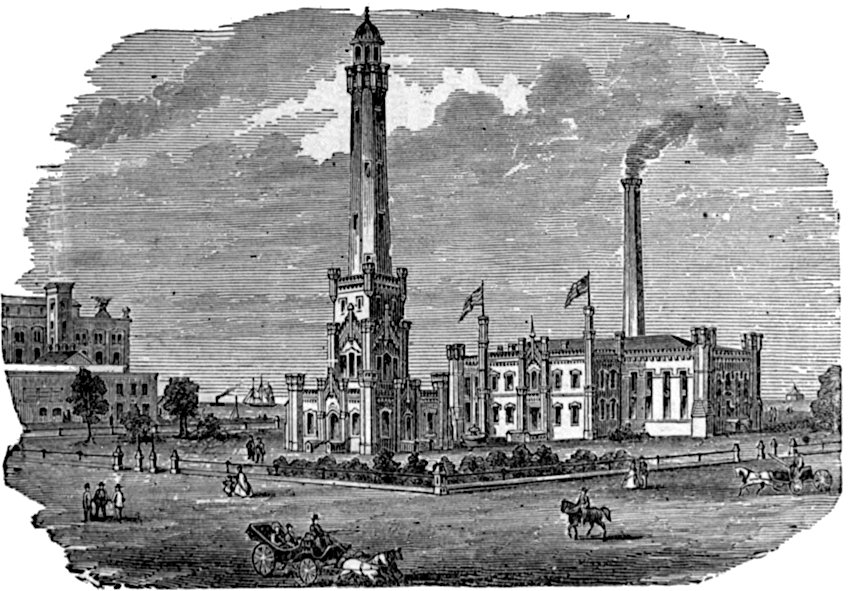
This water tower has the historical privilege of being the second-oldest water tower in the country, but it no longer fulfills the functions that it once did. Instead, it serves as an art gallery as well as the city’s office of tourism. So, it has made a full transition from technical functionality to a full tourist structure.
Rookery Building (1886 – 1888)
| Architect | Burnham & Root, Frank Lloyd Wright (1867 – 1959), and William Drummond (1876 – 1948) |
| Date Constructed | 1886 – 1888 |
| Function | Office building |
| Location | Chicago Loop, Chicago |
The Rookery Building is a 55 m (or 181 ft) tall office building located in the Chicago Loop. It was designed around a unique structure in which the exterior walls are load-bearing while the interior is supported by a steel frame, and this is a transitory construction between older and more modern methods. In addition, it was constructed out of granite, red marble, brick, and terracotta in an architectural style that united the Romanesque Revival style alongside Roman Revival architecture.
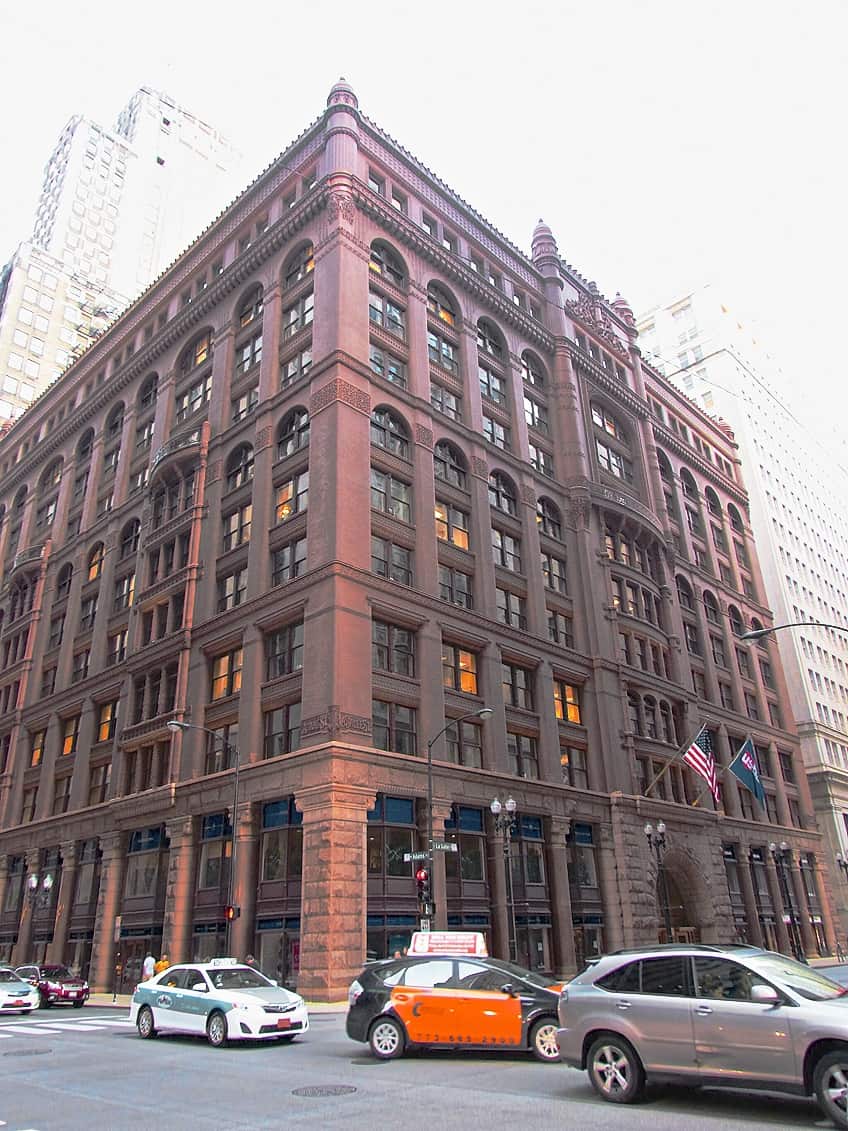
This building has gone on to be one of the most iconic buildings in Chicago, and while it is far from tall by modern standards, the unique design and its place within a transitory architectural construction technique make the Rookery Building one of the most interesting in the city.
Chicago Cultural Center (1897)
| Architect | Shepley, Rutan, and Coolidge |
| Date Constructed | 1897 |
| Function | Governmental building |
| Location | Chicago Loop, Chicago |
The Chicago Cultural Center is a historical location within the city of Chicago, and it served as the country’s first-ever entirely free municipal cultural center. To this day, it maintains a large series of programs and exhibitions for people to join and experience. This cultural center has managed to remain relevant through the years as one of the best locations for social good within the city, but it is also a stunning structure from an architectural perspective.

The cultural center was designed using a Neoclassical design and comes complete with columns in the Doric order, a coffered ceiling within the entry hall, mahogany doors, and green-veined marble walls. It also has two domes of stained glass and is constructed around a symmetrical arrangement comprising two wings to the building. This building has served for well over a century as a stunning piece of Chicago architecture and an important location for many within the city.
Chicago Field Museum (1915 – 1921)
| Architect | Daniel Burnham (1846 – 1912) |
| Date Constructed | 1915 – 1921 |
| Function | Museum |
| Location | Near South Side, Chicago |
The Chicago Field Museum is a museum located within Chicago that had a bit of a controversial construction history as it was originally meant to be built inside a park, but everything was eventually altered to its present location. The building has gone on to be one of the most famous buildings in Chicago and one of the city’s landmarks. The building is especially notable for some of the relief panels that are located on the walls of the structure.

Tribune Tower (1923 – 1925)
| Architect | John Mead Howells (1868 – 1959) and Raymond Hood (1881 – 1934) |
| Date Constructed | 1923 – 1925 |
| Function | Office building |
| Location | North Michigan Avenue, Chicago |
The Tribune Tower is a Neo-Gothic skyscraper in Chicago and while it isn’t the tallest building around by any stretch of the imagination, at only 141 m (or 463 ft) in height (which, in terms of tall skyscrapers, is a comparatively short stature), it makes up for its lack of height by instead being an utterly gorgeous Chicago building. The Neo-Gothic aesthetic design of this early-20th-century building makes it stand out far more than most. The tower is so named because it was the home of the various Tribune media entities, such as the Chicago Tribune, Tribune Publishing, and Tribune Broadcasting.
However, it has not hosted this company for some time, and it also wasn’t the first Tribune Tower.
The original version burnt down in the Great Chicago Fire of 1871. This particular iteration, which is far more famous than the original ever was, had to be built in its place. This Chicago skyscraper’s Neo-Gothic style led to its ornate buttresses and sculptural designs, and many different decorative elements adorn the walls of this famous Chicago building. This includes the many iconic images of figures like Robin Hood and a howling wolf (designed by Rene Paul Chambellan).

Merchandise Mart (1928 – 1930)
| Architect | Graham, Anderson, Probst and White Associates |
| Date Constructed | 1928 – 1930 |
| Function | Mixed-use |
| Location | Downtown Chicago, Chicago |
The Merchandise Mart is one of the many famous buildings in Chicago that, upon its initial construction, it held a world record. In this particular instance, the Merchandise Mart was, upon its completion in 1930, the largest building in the world in terms of floor space. It has, like each and every record of this nature, been beaten many times over by subsequent buildings all over the world. However, the size of this structure is nothing to scoff at even in the present day. This Chicago building can host about 20,000 tenants and visitors every single day, and it is a commercial structure with numerous businesses within its walls.
A very fun fact about this building is that because of its sheer size, the building actually had its own zip code until 2008.
That did eventually change to include some of the surrounding areas, but this one building still comprises the majority of the region that uses that particular zip code. The building itself is an instance of famous Chicago architecture because of its stunning Art Deco design in which the windows make use of ribbon pier designs, the corner pavilions aid the edges of the structure in reducing the appearance of their overall bulk, and the building as a whole makes use of a minimal setback design. It is a gorgeous structure that is still heavily in use to this day, and it will likely continue on in its present form for many years to come.

Civic Opera House (1929)
| Architect | Graham, Anderson, Probst & White |
| Date Constructed | 1929 |
| Function | Opera house |
| Location | Wacker Drive, Chicago |
The Civic Opera House is a gorgeous performance venue that includes the second-largest performance auditorium in North America (which is the building’s main hall), but it also includes a variety of other performance spaces as well as forming part of a larger complex that includes an office tower and two wings. One of the lasting contributions that this building has had does not simply come from it being an important performance venue, but because of its central place as the inspiration behind one of the locations in a very famous film. This opera house adopts an Art Deco style in much of its detailing, which was also quite common for the time, and it is a truly beautiful building that would then go on to have some degree of influence on an important filmmaker. T
his man is Orson Welles, and in his extremely influential and famous film, Citizen Kane, the protagonist builds an opera house for his wife. This opera house would be modeled after the Civic Opera House in Chicago.
So, one of the most famous buildings in Chicago went on to influence one of the most famous films of all time. The reason for this direct influence exists in more than just the structure itself but in an urban legend about its creation. This legend goes that Samuel Insull built the opera house because his wife was not accepted into the Metropolitan Opera in New York. However, this is factually incorrect because his wife wasn’t an opera singer. It is a cute story though.

Marina City (1964 – 1968)
| Architect | Bertrand Goldberg (1913 – 1997) |
| Date Constructed | 1964 – 1968 |
| Function | Mixed-use |
| Location | State Street, Chicago |
Marina City is a multi-building complex that makes use of a mixed-use design in which residential and commercial spaces are presented alongside one another, and it is also a rather massive structure as it takes up most of a city block in Chicago. This complex is comprised of a 179 m (or 587 ft) apartment block, and there is also a 10-story office building that has since been converted into a hotel and an auditorium that was first used as a cinema but is no longer used for this purpose.
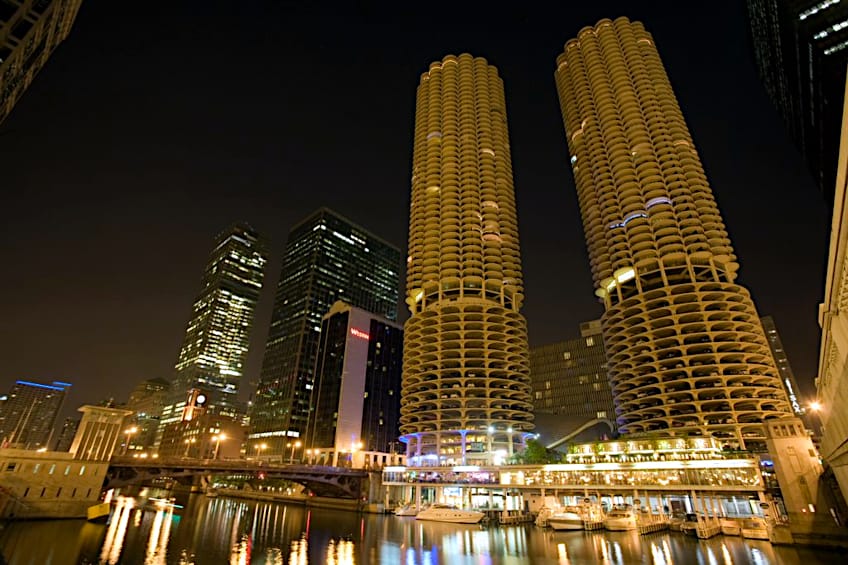
The two tower designs make use of identical floor plans, but they are accessed separately and the entire structure is especially noted for its near-lack of interior right angles. Instead, it makes use of curved designs with a circular hallway that connects the many apartments together. Each of the apartments is also typically constructed in this manner with each of the apartments being designed with the same design.
John Hancock Center (1965 – 1969)
| Architect | Fazlur Rahman Khan (1929 – 1982) and Skidmore, Owings and Merrill Associates |
| Date Constructed | 1965 – 1969 |
| Function | Mixed-use |
| Location | Magnificent Mile, Chicago |
The John Hancock Center is a 343.8 m (or 1,128 ft) skyscraper and one of the earliest supertall buildings in the city. This led to it being yet another of Chicago’s many world-record holders seeing as, at the time of its construction, it was the second-tallest building in the world (but the Empire State Building still held on to that title for some time longer), and it was also, obviously, the tallest building in Chicago. The stature of this famous building in Chicago would be supplemented by its long-standing place as the pinnacle of the city’s skyline, and it likely also achieved some remembrance because of its name.
It is technically named after an insurance company called John Hancock Mutual Life Insurance Company, but as the company is named after one of the American Founding Fathers, the name does stand out within an American city.
However, since 2018, that insurance company has actually left the building and so the owners are looking for someone new to buy the naming rights. It may not have this same name forever. The design of the skyscraper is Expressionist in general layout, and it makes use of an X-braced exterior alongside a tubular design that allowed it to reach far greater heights than those that had been achieved in the past. The interior of the building makes use of travertine, granite, and limestone for many of its surfaces. In addition, the plaza outside the structure makes use of a waterfall and seasonal plants to serve as a public area. It’s a beautiful building that includes a beautiful public plaza.

Willis Tower (1970 – 1974)
| Architect | Skidmore, Owings & Merrill, Fazlur Rahman Khan (1929 – 1982), and Bruce Graham (1925 – 2010) |
| Date Constructed | 1970 – 1974 |
| Function | Office, observation tower, and communications |
| Location | Chicago Loop, Chicago |
The Willis Tower is one of the most famous Chicago buildings from the modern era. It is a 442.3 m (or 1,451 ft) tall skyscraper located within the Chicago Loop region. This building is not only an example of the many famous buildings in Chicago, but it was actually one of the most famous buildings in the world for over two decades because, at the time of its completion, it was the tallest building on the planet. This iconic building in Chicago then retained that title for nearly 25 years of its existence. Today, it is not the tallest or even within the top ten tallest buildings in the world, but it is the third-tallest building in the Western Hemisphere. So, while it may not be in the top twenty, it did last far longer as the tallest building on earth for far longer than most buildings that manage to attain that record.
In terms of Chicago skyscrapers, the Willis Tower is likely one of the most famous and influential.
The skyscraper makes use of aluminum and black glass for its façade and is designed around a “tube” design in which there were nine square tube-like structures that were clustered together to form the overarching structure of the skyscraper. This design, coupled with the massive height, allowed the building to accommodate a whopping 16,500 workers at any one time. This is why the Willis Tower had been used as the Sears headquarters for decades, but the largest current tenant is United Airlines. The building, while no longer holding the prestige of its once record-breaking height, is still one of the most iconic buildings in Chicago.
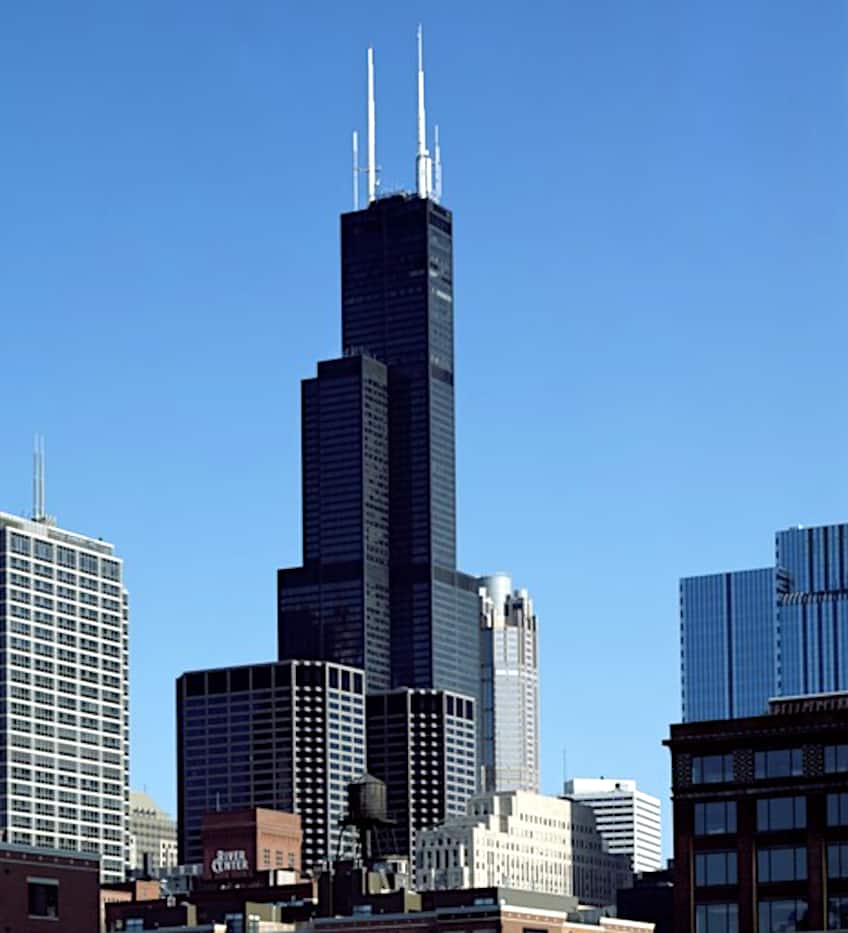
James R. Thompson Center (1983 – 1985)
| Architect | Helmut Jahn (1940 – 2021) |
| Date Constructed | 1983 – 1985 |
| Function | Civic building |
| Location | Chicago Loop, Chicago |
The James R. Thompson Center, which was originally known as the State of Illinois Center, is an instance of famous Chicago architecture that was designed using a Postmodern architectural style. The building had been used as the site of the Illinois state government since it was constructed until 2022, and during that period, it served as the secondary capitol building of the state. However, as of 2022, the James R. Thompson Center has been purchased by Google with plans to turn it into an office complex. The building itself was designed and constructed in the early 1980s, and when it was first unveiled, it received a large number of mixed reviews from many people. Some adored the structure and others heavily criticized it and the Postmodern design that it used in its construction.
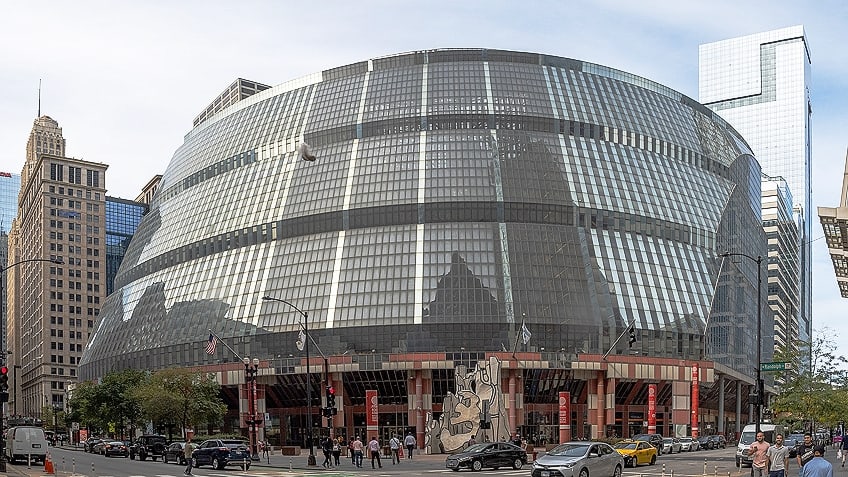
The color, curved design, and more futuristic attempts were divisive for the period. However, in more recent decades, the glass structure has gone on to become a far more accepted part of the architectural landscape of Chicago. It has become one of the most iconic buildings in Chicago, but despite the more recent acceptance of the building, it does have its issues. One of the most pressing issues is that the structure makes use of a single-pane glass exterior, and this means that the building requires expensive air conditioning so that it doesn’t get cold. When it was first built, the interior would ice up in the winter. This is an issue that has still not entirely been resolved.
Two Prudential Plaza (1988 – 1990)
| Architect | Loebl Schlossman & Hackl |
| Date Constructed | 1988 – 1990 |
| Function | Mixed-use |
| Location | Chicago Loop, Chicago |
Two Prudential Plaza is a 303 m (or 995 ft) Chicago skyscraper that has served as the seventh-tallest building in the city since 2022. The building makes use of a setback design with a pyramidal peak at the very top of the skyscraper, and it has gone on to become one of the most characteristic sights in the Chicago skyline because of its distinctive shape and pointed top. When it was constructed, the building won numerous awards as an innovative structure for the modern era. It was completed near the end of the 20th century, in the final days of the Cold War, and as soon as it was completed, it was hailed as the tallest reinforced concrete building in the world.

It, like many other buildings that have attained any kind of a record, would eventually lose that record. However, despite having lost the world title, Two Prudential Plaza still operates as a magnificent example of famous Chicago architecture and one of the most famous Chicago skyscrapers in the city. It has been supplanted in its majestic design by some of the later buildings that would come along and somewhat steal the limelight that buildings of this variety once possessed.
Aqua (2007 – 2009)
| Architect | Jeanne Gang (1964 – Present) and Studio Gang Architects |
| Date Constructed | 2007 – 2009 |
| Function | Mixed-use |
| Location | Columbus Drive, Chicago |
Aqua is one of the most bizarre and distinctive Chicago skyscrapers. The building, upon its completion, was deemed the tallest building in the world that had been designed by a woman, but it was surpassed in 2020 by the final building on this list. So, the tallest building designed by a woman is still located in Chicago, and it isn’t Aqua any longer, but it was still designed by the same architect as Aqua, Jeanne Gang, who is the founder and operator of Studio Gang. Aqua is a peculiar structure because of the façade of the building. It may be a 262 m (or 859 ft) skyscraper, but while the height is impressive, the building is most notable because it makes use of an undulating and irregular design using concrete slabs that, especially from a distance, give the illusion of moving water.
The building as a whole looks as if it isn’t entirely solid in its construction, and it’s a jarring sight to behold.
The inspiration behind this iconic building in Chicago and its odd liquid-inspired design came from the Great Lakes region in which large limestone outcroppings are a common occurrence. So, Aqua made use of a similar characteristic design and it led to one of the most strikingly gorgeous and famous Chicago buildings. It isn’t the tallest building by a woman anymore though, so maybe we should end off by having a look at Jeanne Gang’s next big Chicago building.

St. Regis Chicago (2016 – 2020)
| Architect | Jeanne Gang (1964 – Present) and Studio Gang Architects |
| Date Constructed | 2016 – 2020 |
| Function | Residential and hotel |
| Location | East Wacker Drive, Chicago |
St. Regis Chicago is, to this day, the tallest building designed by a woman (as was mentioned in the section above). It is a 365 m (or 1,198 ft) skyscraper that has only been around for a few years at the time of writing, but even within that short time, it has become one of the most iconic buildings in Chicago of the contemporary era. This building was only completed in 2020, and from its incredible height, the Chicago River can be clearly seen and observed. The building is made up of three separate interconnected towers that are comprised of differing heights. These “stems” form three separate towers that rise from one to the next like a half-pyramid.
They also made use of an undulating design in a similar sense to Jeanne Gang’s Aqua skyscraper.
However, the method used to attain this particular design is distinct from the prior method. In this particular case, different shades of glass are used in alternating patterns, which aids in the undulating appearance. St. Regis Chicago was also designed with different segments as the height increased. The highest tower even makes use of an unoccupied floor that is used as a “blow-through” so that the building does not receive too much wind force without being dissipated. Altogether, the building has become an immensely famous piece of Chicago architecture and one of the most iconic contemporary structures in the city.

We have come to the end of our look at fifteen of the most famous buildings in Chicago, and we have examined an array of iconic buildings in Chicago over the course of this article. We have discussed their general design, functionality, and some of their history at points. Hopefully, you learned a lot about some of these famous Chicago buildings and why they’re so famous in the first place. All that’s left to say is that we wish you a great day/week/month ahead!
Frequently Asked Questions
Where Is Chicago?
Chicago is an American city located in Illinois. It is the third-most populated city in the United States after New York City and Los Angeles, and it has also served as one of the most important cities in the history of the country. Chicago is one of the country’s oldest cities in one of the oldest states, and it has become particularly famous for the many well-known buildings within its bounds.
What Is the Most Famous Building in Chicago?
The most famous building in Chicago may be the Willis Tower. This 110-story building has remained one of the most famous Chicago skyscrapers because it served as the tallest building in the world for nearly two and half decades. The building has also housed important businesses within its walls, such as Sears, and it has an observation deck that has remained one of Chicago’s most popular tourist destinations.
What Is the Chicago School?
Chicago is particularly famous for its architecture. This is because there was a movement of Chicago architects who were known as the Chicago School. They developed the Commercial Style that became a major influence on American architecture. Then, in the mid-20th century, a Second Chicago School formed that heavily influenced the development of Modern architecture around the country. Chicago may have some immensely famous and iconic buildings on its streets, but it is famous for its architects too.
Justin van Huyssteen is a writer, academic, and educator from Cape Town, South Africa. He holds a master’s degree in Theory of Literature. His primary focus in this field is the analysis of artistic objects through a number of theoretical lenses. His predominant theoretical areas of interest include narratology and critical theory in general, with a particular focus on animal studies. Other than academia, he is a novelist, game reviewer, and freelance writer. Justin’s preferred architectural movements include the more modern and postmodern types of architecture, such as Bauhaus, Art Nouveau, Art Deco, Brutalist, and Futurist varieties like sustainable architecture. Justin is working for artfilemagazine as an author and content writer since 2022. He is responsible for all blog posts about architecture.
Learn more about Justin van Huyssteen and about us.
Cite this Article
Justin, van Huyssteen, “Famous Buildings in Chicago – 15 Skyline Marvels.” artfilemagazine – Your Online Art Source. February 14, 2024. URL: https://artfilemagazine.com/famous-buildings-in-chicago/
van Huyssteen, J. (2024, 14 February). Famous Buildings in Chicago – 15 Skyline Marvels. artfilemagazine – Your Online Art Source. https://artfilemagazine.com/famous-buildings-in-chicago/
van Huyssteen, Justin. “Famous Buildings in Chicago – 15 Skyline Marvels.” artfilemagazine – Your Online Art Source, February 14, 2024. https://artfilemagazine.com/famous-buildings-in-chicago/.



